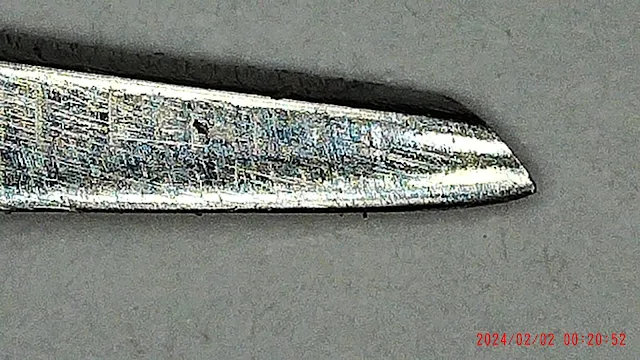The "Onglette" gravers are one of the most well-used metal cutting blades any Engraver or Diamond Setter has in their inventory.
The "Rate of Difficulty" in this program is 7 on the 10 Scale.
This Onglette graver is looking like it hasn't been cleaned in years.
This is an Onglette grinding process that is now taking place. We will now turn the graver on its side and we will then see a 'magnitude of defects'.
Here is a collection of various shapes of gravers. Each of them has seen many months of metal-cutting. Basically, each of them needs to be totally refurbished (again) before being used in Diamond Setting, or Engraving.
These Onglette gravers look bright, but in some instances, we ponder the fact that some of them need to be 'polished' further.
From a distance, the graver brightness is really great, but let's look closer. Just because each of them is shiny doesn't mean that they are good to use!
We are "dedicated to perfection" and this includes our tools of every kind.
The following 7 photographs were taken with my 500x power digital microscope. Those 'little lines' will cause any setter to ponder "What has just happened with my graver cutting?"
No matter how clean it looked, even I was amazed at the rough textured results. YUK!
This graver looks great, but under closer scrutiny and magnification we see many aspects of poor cleaning that has just taken place. The graver operator hasn't seen this 'engraving tool' up close as we are doing right now. HELLO!
With my 500x power digital microscope, I can see how difficult it would be in 'Bright-Cutting'. Those rough spot lines should not be there. The final 'Bright-Cutting' could be quite a mess, the rough texture ceases to amaze me how any 'fine cutting' be established?
This particular graver was used primarily for moving 'beads' over the stone, hence the "uplifted" point.
Can you believe that this graver was used in specific areas in specialized metal carving?
How many of us who use this blog have seen their Onglette blades look like these in the beginning?
The question now is 'How to polish the defective graver' (again)?
These are the actual 'polishing papers' that I use on a regular basis. They are used in sequential order, and these will give you a very highly polished surface.
The side of the Onglette graver must LAY FLAT at all times.
If there is a slight bevel created for the side of the graver, then gently rock the blade to match the surface.
If you have a high-powered loupe, please examine continually how the progress of polishing is coming along.
I would place the blade on the two surfaces of the same paper. One section of the paper will be without any 'rubbing' and the other section will be with the 'rubbing'.
If the paper has #1,200 grit, we can increase the grit to approximately #1,600, or more with the pencil rubbing.
.jpg)
.JPG)
.jpg)












.jpg)






No comments:
Post a Comment